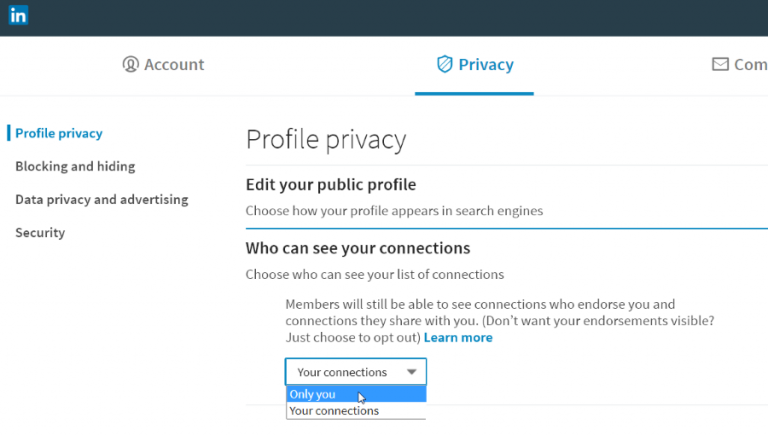Why would a CEO, COO, CMO, CFO or other CXO need to have a LinkedIn profile? That is a good question. Many very high-level / high-visibility C-level executives don’t have a LinkedIn profile. Perhaps this is due to concerns about overexposure. While I certainly understand that concept, the opportunity to leverage your network – whether you are a VP, SVP or C-level executive – has incredible benefits when you do it correctly.
Here are a few tips to help you get the most out of your C-level LinkedIn profile:
Adjust Your Settings & Privacy
I suggest that my clients change the setting for “Who can see your connections” to “Only you.”

This way, your company and your competition cannot see who you are connected to. Overall I think that is a smart move.
The other settings worth noting are what others can view in your public profile. I like to have enough general information show up so if another key decision-maker or executive recruiter saw and liked your profile and wanted to reach out to you, they could. Showing your Summary statement (which should include some contact information) should be enough.

Summary Statement
I like to have an email and maybe even a phone number at the very beginning of the Summary statement. This ensures that people who may be visiting your profile can reach out to you, even if they may be outside of your first- or second-degree network of connections. If you are open to new opportunities, there is no reason to broadcast it, since you can very easily give someone a way to reach out to you!
Worried about privacy? No problem! Set up a new Gmail account with a variation of your name or something that is business-friendly and use that email in your LinkedIn Summary statement.
Keyword Headings
When deciding on your keyword headings, think about what a recruiter or other key decision-maker might be looking for when searching for someone like you. List any advanced degrees, splashy awards, high-level certifications, or size/scope information, such as “Fortune 500 Companies,” “Fast Growth Start-Ups” or “International Expansions.” If you are looking to change industries, think of how broad your industry choice can be without looking as if you are searching for another opportunity.
Depth & Breadth
Most resume writers agree that LinkedIn profiles are best written in first-person informal. Generally speaking, the details in your profile should not be covered as thoroughly as they are in your executive resume. A good rule of thumb is to add just enough detail to create intrigue. Your profile should never, in my professional opinion, broadcast that you are looking for another opportunity.
Grow Your Network
When you grow your network with recruiters and key decision-makers across a few industries and divisions, you are creating a network that can be leveraged. For example, several years ago my husband was complaining that his LinkedIn connections were almost nonexistent. He is in the wine business, so I suggested he find those in “his tribe” through direct searches and LinkedIn groups and invite them into his network. Within 45 days my husband had over 400 of the most powerful global connections of suppliers, distributors, wineries, vintners, wine-recruiters, HR directors and high-profile critics in the wine industry. He regularly receives important information and job solicitations.
The takeaway is that I advocate thinking of your LI network as a tool to connect with like-minded professionals. Personally, I don’t believe you have to “know” these contacts before you invite them. Rather I believe in connecting across industries and disciplines to form a solid foundation with short- and long-term benefits. If a recruiter or other key decision-maker is looking for someone with your skills and abilities and you are NOT in their first or second-degree network, then you will not show up in their search results.
Thought Leadership
Have you read an insightful industry article in FORBES that you agree with? Did you recently attend or, even better, speak at an industry conference? Attend or help lead a community event? Why not share that in your activity feed? Articles are another great way to share your insight, and including pictures or videos will make them more clickable. Remember to keep it all business! This is an excellent way to solidify your brand and thought leadership within your network.
Although there are many other optimization and design tips that are important to know, these tips are great starting points to get you using LinkedIn as a tool that will give you market leverage and solidify your branding message.

